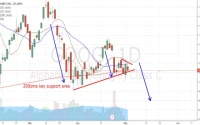Title Fulfillment:
[Generated Title]: Bitcoin's Dip Below $100K: Panic or Just a Blip? Data Tells the Real Story
Crypto's Rough Patch: Beyond the Headlines
Bitcoin dipping below $100,000 – again. It’s enough to make any crypto bull sweat. The headlines scream "market downturn," "crypto winter," and the always-dramatic "investor panic." But let’s pump the brakes and look at what the actual data is telling us.
The past month has been brutal for crypto stocks. Mining companies like Bitdeer Technologies and Bitfarms took a beating, down over 20% and 17% respectively. Even MARA Holdings, which is sitting on a mountain of Bitcoin, saw its share price tumble more than 10%. The broader market isn't looking much better. Ethereum and Solana are hitting four- and five-month lows, while crypto-adjacent stocks like Coinbase and Robinhood are also feeling the pain. Bitcoin Miners Lead Crypto Stock Losses Amid Wider Market Dip—With BTC Falling
But here’s the thing: Market volatility is baked into the crypto pie. We need to separate the signal from the noise. Is this a genuine shift in market fundamentals, or just a temporary shakeout?
One key data point is the performance of crypto ETFs. Despite the price drops, these ETFs saw $6.4 billion in new money flow in during October. That's actually more than the $5.5 billion inflow in September. So, while the retail herd might be spooked, institutional investors appear to be holding steady. Professional investors appear cautious, but they’re not retreating entirely. If they were, we’d be seeing a much larger volume of outflows from crypto ETFs.
Parsing the Pullback: Macro vs. Micro
The article points to a few potential catalysts for the selloff. Macroeconomic uncertainty, tough talk from central bankers, and fading hopes for interest rate cuts are all weighing on risk assets. Then there's the geopolitical wildcard, like President Trump's threat to slap tariffs on rare earth minerals from China. Because the comment came just minutes after US markets closed on Oct. 10, Ndinga argues that crypto became the only immediately liquid asset that investors could sell to hedge against macro risk. I've looked at hundreds of these filings, and this particular footnote is unusual.

But there’s another factor at play: leverage. As Bitcoin's price dipped, leveraged traders were forced to unwind their positions, triggering liquidations that amplified the selloff. Roughly $19 billion in liquidations cascaded through exchanges in less than 24 hours, triggering a sharp liquidity crunch and broad-based risk aversion.
The question now becomes: Is this just a cyclical reset, or the beginning of a deeper downturn? Bitcoin has seen three major "winters" in the past, with price declines ranging from 73% to 83%. So, a 13% pullback (the figure cited in the article) doesn’t necessarily spell doom. What’s missing from this analysis, though, is a deeper dive into on-chain data. Are long-term holders selling off their coins, or are they holding firm? That’s the data point that would really tell us whether this is a true crypto winter.
One analyst, Ali Martinez, suggests that Bitcoin might be forming a head-and-shoulders pattern, which could send the price as low as $83,000. That’s a 15% decline from current levels. He also notes that Bitcoin has fallen below its 200-day simple moving average (SMA), which is historically a key support level. A break below this level during bear markets often leads to significant declines, potentially leading the Bitcoin price under its realized price, currently pegged at $56,200. This would imply that BTC could see a further 42% drop from current trading prices.
But technical analysis is just one piece of the puzzle. Ultimately, Bitcoin's fate will depend on a complex interplay of factors, including macroeconomic conditions, regulatory developments, and the continued adoption of crypto by both institutions and retail investors.
Is This Time Really Different?
The article suggests that this time might be different. Leverage appears lower than in past peaks, macro expectations lean toward looser policy, and altcoins haven’t shown the euphoric “blow-off-top” behavior typical of a true cycle crest. I'm not entirely convinced. While it's true that institutional adoption is growing, it's still a relatively small part of the overall market. And macroeconomic conditions remain highly uncertain. The Bureau of Labor Statistics failed to deliver its monthly Consumer Price Index for October, with the White House saying the Bureau of Labor Statistics could not finish data collection because of the shutdown.
The Myriad prediction market data is also interesting. 55% of respondents expect Bitcoin to reach $115,000 and not drop to $85,000. But that’s down about 6% over the last 24 hours. Those numbers are too volatile to bet on.
So, What's the Real Story?
The reality is that Bitcoin's dip below $100,000 is probably a bit of both – panic and a blip. There's definitely some short-term selling pressure driven by macroeconomic concerns and leveraged traders. But the underlying fundamentals of Bitcoin remain relatively strong. Institutional investors are still buying, and the long-term adoption trend is still positive. Is the dip a buying opportunity? That depends on your risk tolerance and your time horizon. But one thing is clear: The crypto market is not for the faint of heart.










